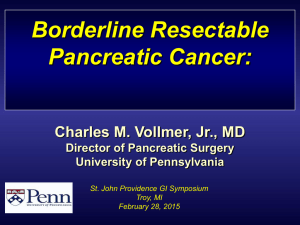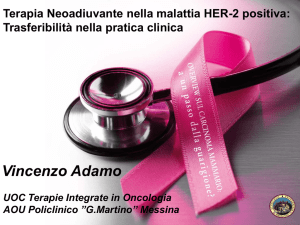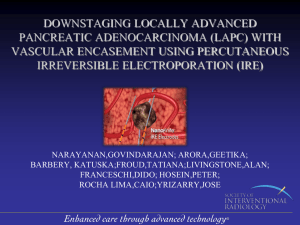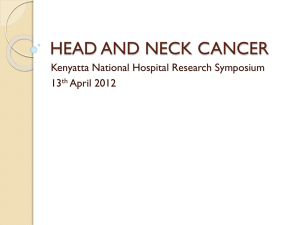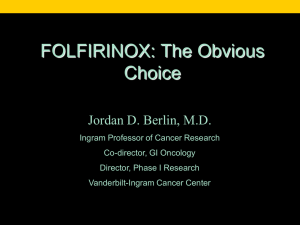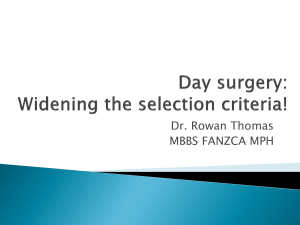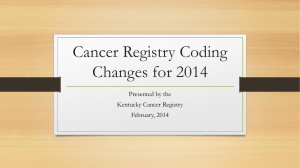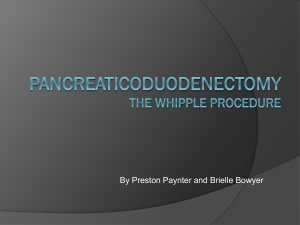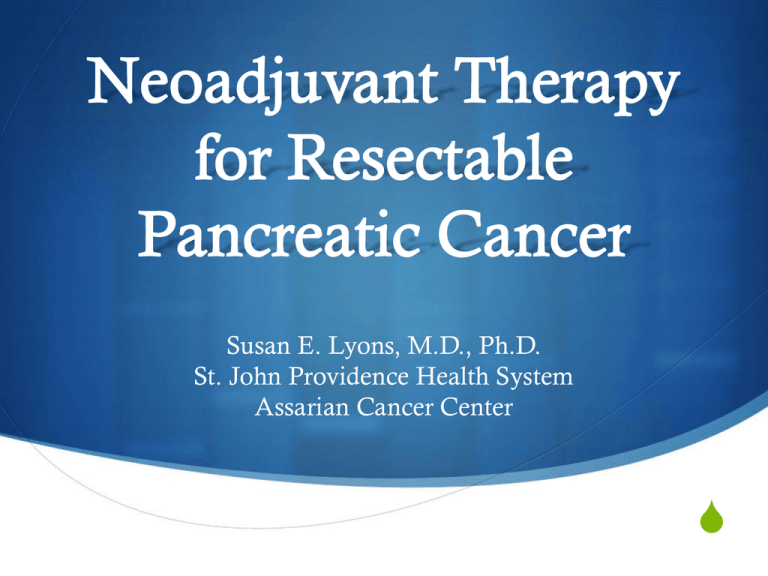
Susan E. Lyons, M.D., Ph.D.
St. John Providence Health System
Assarian Cancer Center
S
Neoadjuvant therapy in
resectable pancreatic cancer
S Not the standard of care
S No randomized data examining this approach
S Yet, it is an idea for which there is much interest
Sobering facts
S 4th leading cause of cancer-related death in US
S Surgical resection is the only curative option
S However, most patients present with late stage disease
S Only 15-20% of patients are resectable at diagnosis
S 5 year overall survival is just 5%
S Disease incidence is slowly increasing
Why does disease present at
advanced stages?
S Symptoms are non-specific
S Bloating, diarrhea, abdominal pain, weight loss
S Distinct signs often indicate advanced disease
S Painless jaundice
S Sudden onset diabetes
S There are no screening tests available to identify early
disease
Why are so few patients resectable?many important structures in close
proximity
Pancreatic cancer staging
IA: tumor <2 cm, limited to pancreas, no nodal involvement
IB: tumor >2 cm, limited to pancreas, no nodal involvement
IIA: tumor extending beyond pancreas, but not involving celiac axis or SMA
IIB: nodal involvement
III: tumor involving celiac axis or SMA
IV: metastatic disease
Pancreatic cancer staging
S Resectable
S Borderline resectable
S Unresectable/locally advanced
S Metastatic
Resectable disease
S
Criteria defining resectability
status
S No distant mets
S No radiographic evidence of SMV or PV distortion
S Clear fat planes around the celiac axis, hepatic artery, and
SMA
Resectable disease
Borderline resectable
Disease
S
Borderline resectable disease
S No distant mets
S Venous involvement of the SMV or PV without distortion or
narrowing of the vein or occlusion of the vein with suitable vessel
proximal and distal, allowing for safe resection and replacement.
S Gastroduodenal artery encasement up to the hepatic artery with either
short segment encasement or direct abutment of the hepatic artery
without extension to the celiac axis.
S Tumor abutment of the SMA not to exceed greater than 180 degrees
of the circumference of the vessel wall.
**Technically difficult surgeries and high risk of margin positive resection
NCCN adapted from Callery MP, et al Ann Surg Onc v 16 (2009), 1727-1733.
Outcomes after surgery
S With resection alone, relapse rate is 92%1
S Local recurrence in 40%1
S Distant mets as only site of recurrence in 50%1
S R1 resection associated with poor prognosis 2
S 15-35% rate of R1 resection rate reported
1Oettle,
2
et al, JAMA (2007) v 297, 267-77.
Chang, DK, et al, JCO (2009) v 27 (17), pp 2855-62.
Adjuvant therapy after resection
Local and Systemic control
S Adjuvant chemotherapy: Gemcitabine x 6 months total
S Benefit for adjuv chemo over obs: median OS 23 vs 20 mo; 5 yr
survival 21% vs 9%1
S Adjuvant radiation therapy with 5FU/Xeloda or Gemcitabine
S Some variation in approaches:
S
In Europe, often use chemotherapy alone
S
In US, usually use both chemotherapy and chemo/XRT.
S Order of therapy varies: many use chemotherapy first or a sandwich
approach (chemo-XRT-chemo)
1Oettle,
et al, JAMA (2007) v 297, 267-77.
Resectable disease only
5 year survival 10-30%
resectable
locally adv
metastatic
Neoadjuvant treatment
S Phase III trial data is not available; must draw conclusions
from retrospective data and phase II data.
S Possible role for neoadjuvant in borderline resectable and
locally advanced disease
S Possible role for neoadjuvant in resectable disease
Benefits to Neoadjuvant therapy
S Early treatment of micrometastatic disease/reduce delays in starting
systemic treatment due to recovery time from surgery
S Reduce positive margins (R1) and lymph node positivity
S Identify patients who likely won’t benefit from surgery: progression of
disease.
S Ensure patients complete chemotherapy (up to 25% of patients do not
complete adjuvant therapy)
S Reduce peritoneal implantation during surgery
S Allow assessment of in vivo tumor chemosensitivity
Problems with
Neoadjuvant therapy
S Potentially resectable patients could progress prior to resection
S Need for tissue diagnosis in all patients
S Frequent need for biliary stenting
Neoadjuvant therapy in BRPC:
Retrospective analysis
S 160 out of 2454 pancreatic patients had BRPC (7%)
S 2-4 months of either 5FU, Gemcitabine, Xeloda, or Taxol
S 63% of patients went to surgery and 53% had
pancreaticoduodenectomy.
S For the 160 patients: median OS 18 mos, 5 yr survival 18%.
S For the resected patients: median OS 40 mos, 5 yr survival 36%.
S 59% of resected patients had recurrence, mainly in distant organs.
Katz, MHG, et al, J of Amer Coll of Surgeons (2008) v 206, pp 833-46.
Meta-analysis of phase II data
on Neoadjuvant approaches
S 14 phase II trials were assessed
S Trials were divided into those with initially resectable
patients (A) vs borderline resectable patients (B)
S In A: 65.8% of patients were resectable after neoadjuvant
S In B: 31.8% of patients were resectable after neoadjuvant
S Median survival in resected patients was 23 mos in A and
22 mos in B.
Assifi MM, Lu X, Eibl G, Reber HA, Li G, Hines OJ.
Surgery. 2011 Sep;150(3):466-73.
FOLFIRINOX
in Metastatic Disease
S FOLFIRINOX:85 Oxali/180 Irino/400 bolus +2400 CI
5FU
S Phase III trial comparing FOLFIRINOX vs Gem
S 342 Patients: metastatic disease, no prior regimens, PS
0-1
S OS: 10.4 mo vs 6.8 mo
S 1 year survival: 48.4% vs 20.6 %
S More toxicity: febrile neutropenia, thrombocytopenia,
fatigue, vomiting, diarrhea, and neuropathy
Conroy, T., et al, NEJM 2011, 364 (19): 1817-25.
Conroy, T, et al NEJM, v 364 (2011)
FOLFIRINOX
and Gem/Abraxane
REGIMEN
Partial response
Stable disease
Progression
FOLFIRINOX
31%
39%
15%
Gem/Abraxane
23%
27%
20%
Conroy, T, et al NEJM, v 364 (2011)
Von Hoff, et al NEJM v 369 (2013)
Neoadjuvant for borderline
resectable or LA disease
Bittoni, et al., Gastroenterology Research and Practice (2014),
Retrospective analysis:Resectable vs
BR/LA +neoadjuvant
FOLFIRINOX
188 patients
87 immed
resection
Lower stage
40 (25 LA and
15 BR)
FOLFIRINOX
61 other
neoadjuvant
Higher stage
Younger
Fewer co-morbidities
Ferrone, CR, et al, Annals of Surgery v 261 (2015).
Results of retrospective analysis:
Resectable vs BR/LA +neoadjuvant
FOLFIRINOX
S Longer surgery times and more blood loss in neoadjuvant
group, but no difference in post-op morbidity
S 35% +LN in neoadjuvant vs 79% in immediate resection
S 92% R0 in neoadjuvant vs 86% in immediate resection
S Only 11 mo f-u: 38% progression in neoadjuvant vs 49% in
immediate resection
Ferrone, CR, et al, Annals of Surgery v 261 (2015).
Conclusions from the analysis of
patients treated with Neoadjuvant
therapy (LA/BR)
S Patients with BR or LA disease treated with neoadjuvant
did as well or better than those with resectable disease.
S Longer follow up is required.
S Resectability was difficult to determine by imaging after
neoadjuvant therapy.
Ferrone, CR, et al, Annals of Surgery v 261 (2015).
Conclusions from the analysis of
patients treated with Neoadjuvant
therapy (LA/BR)
S After FOLFIRINOX:
S By imaging:
S
S
S
19 LA
9 BR
12 Resectable
S At surgery: 92% R0 resections
S Clear fat planes were not seen, but at surgery there was fibrosis
rather than viable tumor.
S Imaging cannot distinguish between fibrosis and tumor
Ferrone, CR, et al, Annals of Surgery v 261 (2015).
Currently registered NIH
sponsored neoadjuvant trials
S 70 trials come up in search using “neoadjuvant” pancreatic trials
S Majority are pilot studies or phase II studies
S Many are assessing FOLFIRINOX or some modification of
FOLFIRINOX
S Some are assessing Gem/Abraxane or combining with
FOLFIRINOX cycles
S Varying combinations of chemotherapy and
chemotherapy/radiotherapy
Current Phase III trials for
neoadjuvant in pancreatic
cancer
S NEOPAC (Switzerland)
S Resectable disease
S Arm A: Gem/Oxaliplatin x 8 weeks->Surgery-> Adjuv Gem x
6 months
S Arm B: Surgery->Adjuv Gem x 6 months
Current Phase III trials for
neoadjuvant in pancreatic
cancer
S NEPAFOX (Germany)
S Resectable disease
S Arm A: Surgery-> 6 cycles Gemcitabine
S Arm B: FOLFIRINOX x 6-> Surgery-> FOLFIRINOX x 6
Providence Protocol
S Plan a trial for borderline and locally advanced panc ca
S Enroll all patients eligible for treatment
S Goals: resection, PFS, OS
PROPOSED PROTOCOL:
6 cycles of FOLFIRINOX->resectionadjuvant Gem/XRT
If unresectable: Gem/XRT and reassess for surgery.
Goals for pancreatic cancer
treatment
S Increase number of patients who are successfully resected
using neoadjuvant approaches
S Define optimal neoadjuvant approaches: what
chemotherapy? +/- neoadjuvant radiation vs adjuvant
radiation.
S Reduce recurrence rates
S Improve supportive care for patients going through therapy

